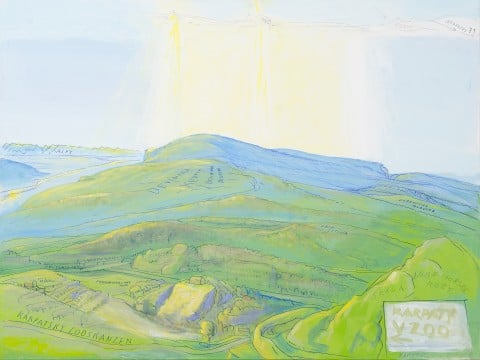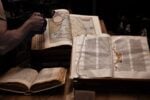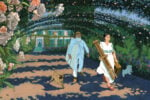On directing air

Mostra collettiva.
Comunicato stampa
on directing air.
text on works by peter bartoš, kveta stano filko, květa fulierová and
július koller, written by petra feriancova
epistemology, as well as biology, both recognize irrationality. in biology it
is predominantly a reaction, assuming there is stress for time, which often
leads to revolutionary solutions. it is possible that irrationality, so
closely entwined with an emotion and a subject, can generate the ability for
animals to make decisions, which are not controlled by the devised
instinctive behavior, but with individual feelings. maybe this revolution is
a fault in evolution – it is the failure of this instinct. or it is the
result of a balance, which is accordingly paradoxical. irrationality is
related to causality, temporal and emotive stress, a memory – a sum of data
and trauma. mathematics has the expression reductio ad absurdum in reference
to irrationality. but are we able to define such an entity? one, which words
will not suffice to describe, which is immeasurable, volatile, unpredictable
and thus, essentially nonessential? we are aware of this entity, we sense it;
it is something ascertained, it exists – albeit it does not follow the
rules. we often perceive the impossible, the absurd or the inability to grasp
and comprehend as something ominous or as a sort of threat. we have a need to
quantify and depict everything… even intuition; a pitch that one cannot
quite discern or a molecular bond making up the structure of a human tear. we
know what it is to look through a fly’s eyes, we have mastered suggestion,
perception, the states of human consciousness have long been explored. yet
the subjective emotions, idiosyncrasies and incentives, which guide one’s
action and make up an individual are still largely unknown.
the whole system, it appears, functions on the constant violation of rules. a
priori or irrational behavior can be a necessity for a balance in physics and
biology. simply put: the world counts on irrationality to exist; it is its
component and paradoxically irrationality also plays a part in its
equilibrium.
when you listen to peter bartoš, apart from a taste of a postmodern cocktail
you get an intense feeling, as if the basic communication agent – language
– had exploded and words flew in all directions. but if you put them back
together, everything makes complete sense. peter bartoš works the same way
he talks. his works act in a similar “volcanic” manner, erratically. the
post-production process in the gallery is practically without an end. nothing
is ever settled – the discourse continues.
the exhibition at amt_project in bratislava came together gradually and very
slowly. peter began in the kitchen by exhibiting his concept of the
environment* dating back to 1969. we met one spring morning and we went for a
walk to the presidential garden. peter took out a picture from his briefcase
and said, that he had just come from the slovak national gallery, where he
had an appointment to meet with a theoretician, who did not turn up in the
end. he made an action out of his waiting for her. and so he left with his
concept and hung it in our kitchen. it hung there on its own for a few days
and then a second project, related to the first, was added. then he began
installing his study of the extramural settlement of bratislava in the
corridor, where we had panels brought in so that the radiators were not in
the way. every day he would come in and slowly and carefully construct an
image of the extramural settlement, made up of various photocopies of various
sizes, which are more or less related to one another in an interesting
dynamic, which is comprised of various perspectives. later he left this work
behind, and filled the surrounding wall with other references. these were
newspaper articles, collages, or collages combined with painting. bartoš
adds that it would be appropriate to leave the rest of the space for others
to fill.
one day he came with an idea of a home as the main theme of the exhibition,
which he began to realize in the first room of the exhibition. he drew
landscapes masterfully onto wrapping paper and onto pieces of textile, with
the precision of maps, in a slight perspective and with the plasticity of a
mountain range. it is here that he returns to his spiral**, and to the place,
where he was born. he placed an image of a study accompanying a plan for the
zoological garden, where he adds a black and white photocopy, which refers to
the image. (bartoš’ xeroxed copies are actually the concepts and he
himself considers them to be the most important.) these, in this case move
the spatial limits of the image. bartoš expands his work by drawing, and he
attaches pieces of textile or paper in an improvised manner to the work,
which has already been installed, so that he would have the possibility to
draw outside the limits of the format. this foundation, but also older
paintings have their designated space on the wall. they can be understood as
individual elements and the wall is the final image. even so, a little
dubious, because the image in bartoš’ understanding acts volcanically, in
a procession and expansion. it has no limits or an end. midway through the
room peter stops in a slightly irrational manner and asks for other artists,
his guest, to finish his installation.
he asks me to amend the extramural settlement, however i only manage to find
some material from when i was walking my dog, documentation pertaining to
older houses with gardens and some small villas, which no longer exist. he
wants koller’s work, because as he says, koller has a question mark, and he
has an exclamation mark.*** naturally also because of koller’s post
production of the everyday, for which i suggest to ask květa fulierová to
collaborate. and so a fairly discursive installation of images from various
sources (my archive, the archive of květa fulierová and other works of
peter) takes shape. peter advises on where everything should be positioned
– “here you begin with the birds, the grandfather, then you continue with
the pigeons, then you move onto the church, here you put the children, the
bathing of the children, cooking, the pioneers’ garden…. what – do you
not bathe your children!?” in principle i managed to listen to peter’s
advice for the idea of the concept for the room, which was designated for me
and i brought material, which i was able to find, or rather which i thought
of as relevant. i use some of his xerox photocopies as a resource, around
which i try to exhibit something, as if a network of image associations,
which freely diverge from given arguments. peter reacts to these
installations again with one of his drawings, or and older concept. as a
result, the images become, as if, words, and their organization as if a
syntax, an installation. an attempt at a dialogue.
bartoš continues to amend the exhibition, even after the opening, which is
slightly reminiscent of stano filko, who returned every day to work on his
exhibition in amt in 2012. nor he, nor bartoš came to the opening of their
exhibitions. the difference in this never ending summarization, in the case
of both artists, is probably that, peter fills in and filko changes concepts,
very often with by a palimpsest, or destruction of that, which already
exists. for bartoš the exhibition space is as if a lecture hall and the
concepts are didactic aids. he often tells me he is only exhibiting his work
so that the exhibition, in this case his extramural settlement, will spark up
a discussion and therefore has a meaning, a will move things forward. both
stano and peter like to give instructions to someone, who will finish their
work for them.
květoslava fulierová’s photographs form a great resource and the basic
element of koller’s post-production work. relentlessly and readily, she
documented most of their time spent together; their travels, the work, the
meetings of artists at kudlakova street number 5, as well as the games for
their grandchildren that they invented. not a single moment is left without a
record. it was as if she and koller orchestrated some kind of a register, a
testament to history. it seems that in koller’s and květa’s case, each
day in the life of a human being was meaningful.
a person of that era, my parents’ era (a generation born during the second
world war, or a few years before), had boundaries left and right, in fact on
all sides, but he or she also had the wide sky above. this sky was the sky of
the second half of the last century with first big travels to space. i cannot
fully understand the euphoria and the feeling of that period. whether they
truly felt a certain collective pride of a particular achievement of the
civilization, without an allegiance to the party. it was the sky or the
universe was understood to be apolitical – it was a territory of the
infinite, beyond the earthly reality.
in his gallery ganku project, koller thematizes the essence of the utopian
vision in his unrealizable running of an artistic gallery, located in an
inaccessible place in the tatra mountains. his mastering of the bureaucratic
style is also clear when reading all of the regulations, which he in all
seriousness wrote down for the gallery. it is a word-factuality, which adds
an almost ironic seriousness to koller’s utopian concepts. in effect,
koller goes much further – crossing the borders of our geopolitical
situation. superlatively and out of this earth. gallery ganku and its program
are intended for the extraterrestrial spectator.
the limited opportunities of that political era created a certain feeling of
permanence, stability and security in the sense that art was not and never
would become a tool to make a living, and certainly not a way to get rich.
because of that artists experienced more creative freedom. koller’s
colorful paintings made for the dielo shop are, therefore, not supposed to be
understood as halfway solutions, or as a way to avoid plight. in his case
there is always a point that he, as the author himself, does not necessarily
need or want to be understood by the spectator. peter bartoš reminisces that
koller did not even have any extremely provocative intentions, he did not
have conflicts with the regime; basically he would see certain magic in those
ambivalent situations and then he would work with them further.
his whole body of work is comparable – it is not so much intentional as it
is exploratory. koller does not suffer when he works; he revels on that,
which he finds and that gives him unbelievable credibility and at the same
time subtlety and ease. koller institutionalizes each and every moment of his
day in this serious easiness, or rather easy seriousness. daniel grúň
writes of “self-historicizing” in the catalogue of gallery ganku.**** self-
historicizing, understood in its pure core, where one realizes his or her own
temporality. i, myself would take photographs of nothing, only to measure my
own time. the act itself was not an image, but a situation where i was
wasting both photographic material and my own time.
pythagoras was the first to identify the diverse content of the world using
the word “cosmos”.
cosmos is, apart from the definition of the origin of the world, also a term
for individual organization, orderliness. it is an antagonist demarcation of
oneself from a parallel phenomenon accompanying the creation of the world,
that which is chaos.
anaximander also uses the term “cosmos” in relation to the universe, but
in pythagoreanism it has a meaning leaning more towards harmony. cosmos
represents a system, which functions perfectly, and a system, which humankind
tries to emulate with its creativity in the course of history.
the art of stano filko is in its size almost a parallel world to ours. with
its diversity and corporeality it speaks of an incredible energy, will and
talent of one person.*****
it is interesting, that this world – a colossus – has an absolutely
perfect inner order; it is functional, but also combinatory, also despite
many manipulations, moving or even destruction of the works (also by filko
himself). it is possible to rearrange filko’s work, constantly; and if one
starts, it is impossible to stop, one simply has to, wants to orientate
oneself in his work – understand it.
filko’s work is unbelievably complex and creative at the same time; it can
work as an array, but also individually. even fragments, which were taken out
of filko’s context by force; or even as a part of individual objects or
installations, work on their own. they dispose of a large creativeness, which
is something i miss as an artist without a studio.
filko’s work left koliba, it was assembled in veľká hradná, there it was
taken apart to mere parts, sold and then exhibited again. even after such a
terrible destruction of this world, one can still preceive it and its size is
indisputable.
at the same time filko’s world, or rather his work, is very biographical,
almost hypochondrically obsessive. apart from notoriously known clinical
deaths, there are new references about his lifestyle. filko counts the days
passing by. he creates objects out of empty butter milk cartons and mineral
water bottles. perhaps it is an apriori artistic conversion of everything
that he comes across, or the bottles have a symbolic meaning. filko’s
mineral water bottles from his last days are punctured with metal rods with
tape stuck to them. the bottles were donated during the opening of the
exhibition ****** and so people could leave with an object, which was a part of
filko’s basic human need. filko as if ritualizes his day-to-day, which is
at the same time known to us all.
filko constantly recreates and cretes new constelations from his own
installations and environments. he paints over, rearranges, and dates back,
or does not date at all. he always states the older dates, even though the
works were post-produced – filko’s dates almost never correspond to the
reality. filko alone constantly changes them. for filko time is a subjective
matter. filko creates it. filko does the opposite of dating back.
————————————
*here only environments, because they began to deal with “the environments
of the park” only later. in this case it was an unkempt terrain near
dúbravka.
**the spiral or nomad art is bartoš’ long-term project. it came about, as
he himself says, because he did not have a citizenship, so he pin-pointed a
point in the town of uhrovec, because that is where two important lutherans
were born (štúr a dubček). it is the center of a circle, and a few hours
before the separation of czechoslovakia, bartoš began his pilgrimage in
břeclav. the circle reached the hungarian border, which it surpassed and
because of his political ideals, he turned and returned; and so the circle
became a spiral.
***the exclamation point is an important project for bartoš, as he himself
adds, a breaking point, “it should be in the slovak national gallery, i
should ask for it back.”
****grúň, daniel, koller, július, galéria ganku, schlebrügge.editor,
vienna, 2014. 124 p, isbn 978-3-902833-55-6
***** the theoretician jan verwoert, calls filko’s work an attempt at depicting
the world, “his work is the world”.
****** the last solo exhibition of stano filko - erupekcia - orgiazmus - orgazmus
- yang - jin = slnkomesiac - in life - love - entita - exist - beingsf -
hermafrodit kazdemu podla svojich moznosti a schopnosti - v - in -
5.4.3.d - pre zivot singular truths vsetkych ludi na tejto zemeguli -
tranzscendencie - v - in - existencii - len v 3.d.



